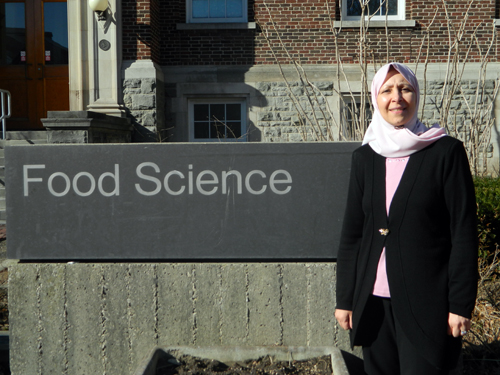
For many people, bread is a part of most meals: a little toast for breakfast, a sandwich for lunch or rolls in the bread basket when you have dinner at a restaurant. But white bread can cause spikes in blood sugar because its starch is quickly digested and it may lack the nutrients that are important for health.
“Consumers want more from their foods today,” says food science professor Sanaa Ragaee, who has been manager of the cereal program at U of G since it started in 2008. She works on the development of grain-based “functional foods,” which can boost health and help prevent disease.
Enhancing the bioavailability of antioxidants in grain products is one focus of her work. Ragaee explains that normal metabolic processes in the body produce free radicals that could damage cells and important biological molecules in the body. This could affect immune function and trigger diseases such as cancer, heart disease and Alzheimer’s disease. Antioxidants in food – found in higher quantities in whole grains than in white flour — or those added to food can capture those free radicals, slowing down cell damage.
Clearly, antioxidants are important, so it would make sense to add as many as possible to food, but it doesn’t work that way. Ragaee explains that processing and storage can affect antioxidants. “We need to have a better understanding of the effects of agriculture production, handling and processing on the end product,” she says.
Her research on this topic has shown that these effects can vary widely. In some grains, baking or roasting can actually increase the amount of antioxidants, while other grains experience a decrease. Her 2014 paper on “The Impact of Milling and Thermal Processing on Phenolic Compounds in Cereal Grains” covers current research.
Ragaee has built on this knowledge to develop bread that incorporates bran from other grains to boost the antioxidant content. Not only does the extra bran bump up antioxidants, but Ragaee also found that the digestibility of the starch in bread was reduced, which would reduce the risk of sharp increases in blood sugar.
This process also extended the shelf life of the bread, keeping it moist and flavourful for a longer period of time than ordinary whole wheat bread. Those results were based on laboratory tests; she’s now collaborating with the glycemic laboratory to see how the added bran affects people who eat the functional bread developed in her laboratory.
She’s also working on a study of frozen bread dough, an increasingly popular product for food services to conveniently provide fresh bread. Ragaee’s goal is to increase the shelf life of frozen dough by adding sources of prebiotics, something that consumers often look for to improve their health. In this case, the prebiotic is beta-glucan, a soluble fibre found in oats and barley. Currently, two graduate students working with Ragaee are investigating the incorporation of beta-glucan and other prebiotics in frozen dough.
For some people, grains such as wheat, rye and barley can be problematic. Those who have celiac disease can’t tolerate any gluten, while others simply choose to avoid wheat. As gluten-free products become more popular, Ragaee has begun working on a tastier, healthier gluten-free baking mix.
“In one of my classes I asked my students to make gluten-free cookies. One student bought a ready-to-use baking mix, and those cookies were not good – they tasted like beans,” she recalls. With that in mind, Ragaee is trying to create a mix that can be used for gluten-free baking with more fibre and more protein than the ones currently on the market. Her plan is to use millet, quinoa and canary seeds to create a baking mix that can be used to stir up tasty and nutritious foods that will have a flavour similar to those made with wheat flour.
Sharing what she discovers in her research is an important part of Ragaee’s work; she’s a frequent speaker at conferences and has published research papers and book chapters. She also works hard to build connections with food manufacturers, pointing out: “Most food science graduates go into product development, and having industry funding lends weight to your research.”